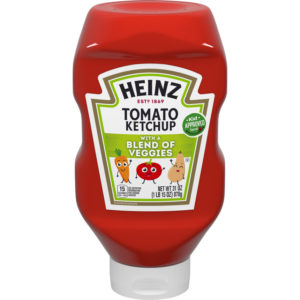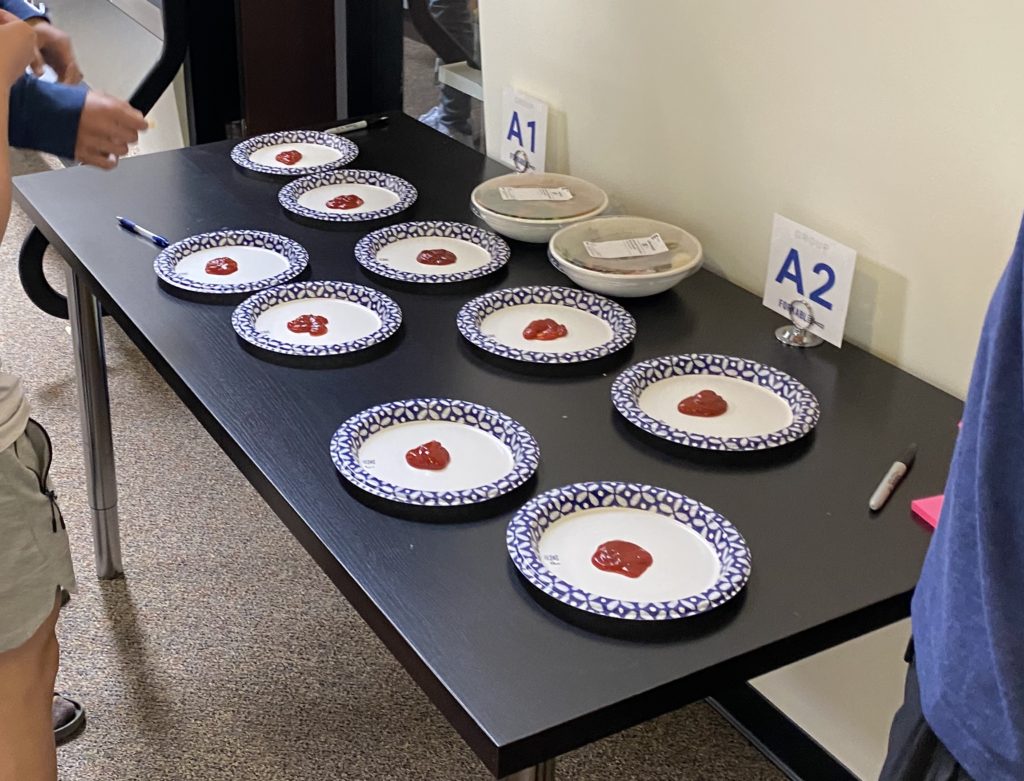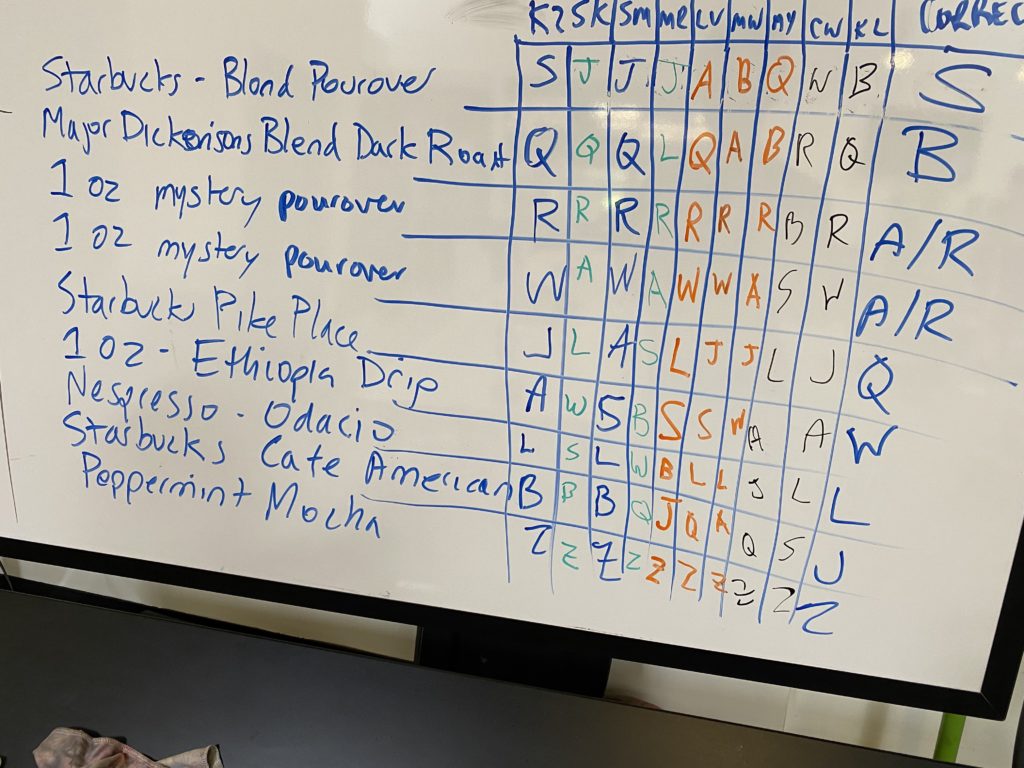Recently, a coworker mentioned that growing up, he had blue ketchup. It didn’t taste different. It wasn’t some other type of tomato. Heinz just thought it would be fun to put blue food coloring into ketchup.
Although it’s no longer available, this product wasn’t the end of Heinz’s innovations in ketchup. In fact, in our fridge, we currently have this variety: “Heinz Tomato Ketchup with a Blend of Veggies“

The “Blend of Veggies” suggest it might be a lot of things, but it’s exactly the three pictured: tomatoes, butternut squash, and carrots. As far as we could tell, it basically tastes like ketchup, except with slightly less guilt when we squeeze it onto our daughter’s plate.
And this is only one of about a dozen varieties I counted on the Heinz website, which certainly means there’s more out there in the wild.
All of this research, of course, led us to the question of whether there’s actually a difference in flavor, and if so, which is the best ketchup?
And the only answer is a taste test.
The ketchup taste test procedure
After rifling through the basket of assorted, leftover ketchup packets at the office, my coworkers and I embarked on a scientific journey to find the best ketchup out of nine varieties.
Here’s the setup.
Away from everyone else, I squeezed out roughly equal portions of each ketchup onto paper plates. I put a number on each plate with a sticky note and separately maintained a key to match numbers with ketchups.
If I had left the experiment there for testing, we would have a single blind taste test. It probably would have worked well enough for everyone else, but not for me.
So, I then walked away and asked one of my coworkers to assign a letter to each plate. He removed the sticky notes with the numbers and maintained a key to match numbers to letters.

After that, no single person had enough information to match ketchups, but we could figure it out together.
For the actual test, another coworker ran down to Jack in the Box and picked up fries. We put a big grid up on a whiteboard for everyone to assign their ratings for the ketchups. We didn’t give any instructions on how to rate them since these were really personal opinions anyways. The only hard requirement was for each taster to circle their favorite ketchup.
The ketchup taste test results
First, after about three samples, the ketchups all started to taste the same.
Someone suggested there might be an actual scientific principle behind this, but no one verified that. Regardless, my attitude going into the taste test was that we would get the most accurate results by including as many options as possible. Given another chance, I would run the experiment differently.
However, it’s possible that they really do all taste the same. We had several Heinz varieties, and I would guess that many non-Heinz brands aspire towards that same, familiar taste.
Second, Trader Joe’s was consistently rated poorly. It definitely tasted different from the others, and not in a good way. Later, Julie, who was visiting the office that day, suggested that it toes the line between ketchup and barbecue sauce by introducing other spices and flavors.
Third, the most consistent winner was Heinz Organic, which is in fact the variety we stock in the office.
Fourth, both Julie and I rated Heinz Veggie highly. Neither of us picked it as our winner, but it was good enough to keep.

And that was about it. We enjoyed the experience and would recommend it to others, too. When you’re at the end of one bottle, buy another variety, and hang onto your ketchup packets along the way. Do a double blind taste test with a half-dozen varieties and see if you can find a difference.

Another type of taste test
I don’t drink coffee. The last time I drank coffee was freshmen year of college when I had meal plan dollars and wanted to try something new. With my first sip, I learned that I don’t like coffee without a lot of sweeteners. A half hour later, I learned that caffeine gives me splitting headaches.
I probably would get past the headaches by developing a tolerance over time, but given my aversion to the flavor, I never saw any reason to try.
That being the case, I stick out in the office where we otherwise have a strong, expensive coffee culture. Cultivated coffee drinkers appreciate the difference in quality and the tasting notes and such. As an outsider having just done a ketchup taste test, I thought we should put the team to the test: could we tell the difference between “good” and “bad” coffee?
The coffee taste test procedure
That morning, I asked everyone to bring in a cup of coffee from somewhere. I presume coffee shouldn’t be room temperature, but we had to control for different arrival times.
Again, we did a double blind setup where I mapped coffees to numbers, and a coworker mapped numbers to letters. We set all of the coffees out in identical cups and put a spoon in each to transfer to individual cups to taste.
This time, instead of rating the coffees, we received the list of coffee varieties and had to guess which coffee was which.

The coffee taste test results
First, I still don’t like the flavor of coffee. I didn’t enjoy even the nice ones.
Second, a lot of coffee doesn’t taste like much. Some of the lower-quality coffee tasted watery, and it was actually still worse because of it. It reminded me of filling a glass with water after having just a bit of orange juice left in the bottom.
Third, we all nailed the peppermint mocha. Other than that, it was quite difficult to match. We could tell which coffees actually had flavor, but we had more difficulty matching specific varieties. I think the best result was getting 5 out of 9 correct, which the average around 3 or 4.

Here’s another take from one of my coworkers on the experience.
Final Thoughts
On the one hand, as a foodie, I’m always seeking out new food and looking for the best culinary experience. In theory, these sorts of taste tests apply science to the process to find the perfect match for my palate.
I also have wondered whether refining the palate actually makes us happier. On the one hand, a chocolate connoisseur can appreciate high quality chocolate. On the other hand, that may ruin a regular Hershey’s bar forever. More generally, maybe ignorance is bliss if we can enjoy objective average experiences.
But reflecting on these taste tests, I realize that it’s really about the experience. I’m not sure I will ever think about ketchup so much, and I’m not planning to start drinking coffee anytime soon. The deliberation and quest is all part of the experience. In fact, it may even be more important than the flavor itself.